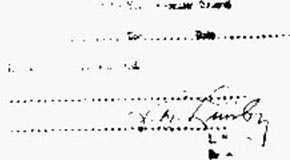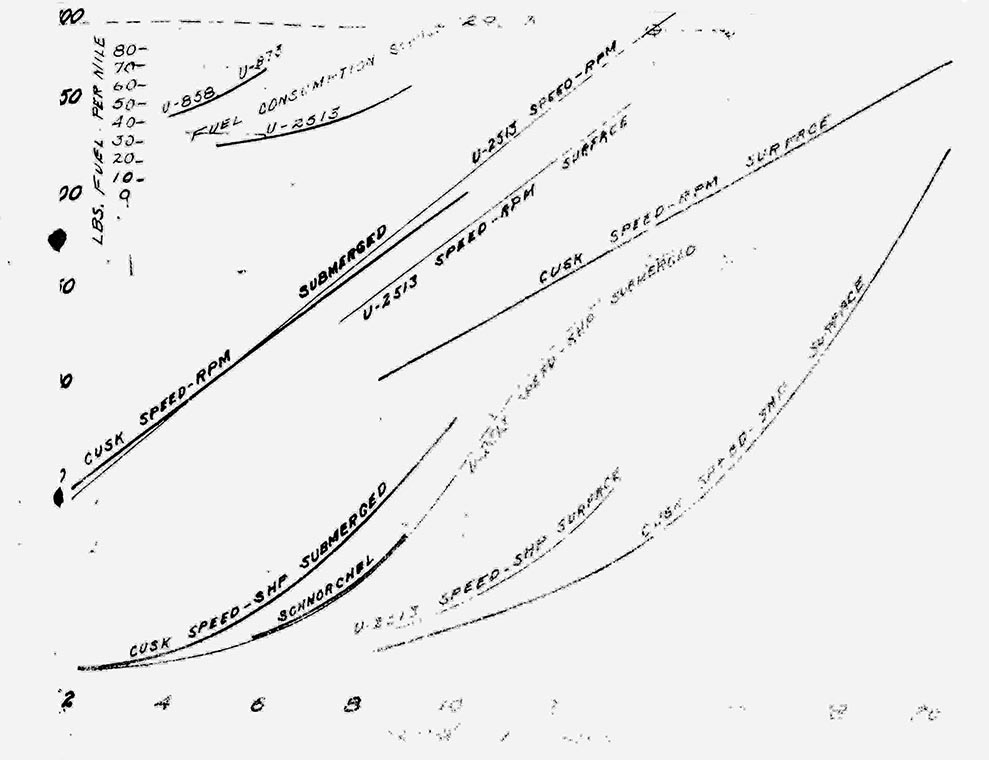| |
|
|
| |
|
|
| |
TML |
|
| |
EF30/SS/S1-3(1445-S) 16 April 1946 |
|
| |
- - - - - - - - - - - - - - - - - - - - - - - - - - - - - - - - - - - - - - - - - - - - - - - - - - - - - - - - - - - - |
|
| |
|
|
| |
Enclosure A is submitted as a matter of interest to illustrate the influence of the design features of the latest type high submerged speed type German submarine, (U-2513), on its performance as compared to the performance of a U.S. fleet type submarine, (CUSK), having the same surface displacement. |
|
| |
|
|
| |
Comparative characteristic values of the two submarines are listed in the following table: |
|
| |
|
|
| |
| |
U.S.S. CUSK |
U-2513 |
| Displacement surface |
1809 (normal) |
1819 |
| Displacement submerged |
2428 |
2100 |
| Positive buoyancy |
34.2% |
15.4% |
| Draft |
15' 1-1/8" |
20' 8" |
| Length overall |
311' 9" |
251' 10" |
| Beam maximum |
27' 3-1/2" |
21' 8" |
| Horse Power eng. surface |
5400 |
2228 |
| Horse Power motor submerged |
2700 |
4500 |
| Horse Power eng. submerged |
none |
1500 |
| Speed surface maximum |
20.3 |
13.7 |
| Speed submerged maximum (motors) |
9.9 |
15.6 |
| Speed submerged maximum (eng.) |
none |
9.0 |
|
|
| |
|
|
| |
3. The following departures in design from the U.S. Fleet type submarine were noted in the U-2513, this type being used for discussion since it includes all the features of design of interest on other German types and those features which may contribute to the unusual performance of this type noted in enclosure A. |
|
| |
|
|
| |
a. Hull |
|
| |
1. Form - The hull is tapered from a bulbous bow to a fishtail stern. Six torpedo tubes are located forward and all torpedoes are stored forward in a large torpedo room. No stern tubes are provided. |
|
| |
Streamlining is obtained by greatly reducing the superstructure and conning tower, by eliminating protuberances such as anchors, deck guns, periscope extended supports, life lines, cleats, stub masts, etc., and by fairing as noted, in rounded corners of superstructure and conning tower and deep fillets, enclosing AA guns in fairwater, covering bridge opening (allowing only shoulder holes), streamlining Schnorchel and cutting narrow horizontal flooding holes in superstructure. Periscopes, radar and Schnorchel are completely housed in fairwater. |
|
| |
 |
|
| |
- 2 - |
|
| |
|
|
| |
|
|
 |
 |
 |
| |
|
|
| |
|
|
| |
TML |
|
| |
EF30/SS/S1-3(1445-S) 16 April 1946 |
|
| |
- - - - - - - - - - - - - - - - - - - - - - - - - - - - - - - - - - - - - - - - - - - - - - - - - - - - - - - - - - - - |
|
| |
|
|
| |
10. Engine exhaust used to dispel water from main ballast in lieu of low pressure pump. |
|
| |
11. Underwater exhaust for main engines, (surface) to reduce noise and smoking. |
|
| |
|
|
| |
4. As compared with the standards of the U.S. Fleet type submarine the general arrangement and workmanship was poor. Conveniences were decidedly lacking particularly berthing, messing, washing and toilet facilities and embellishments such as manifold covers, kick plates, linoleum decking, heavy metal partial bulkheads, etc. Apparently to save weight and reduce man days in construction the Germans had eliminated many emergency and safety features. |
|
| |
|
|
| |
5. In conclusion, the Board desires to point out that in the type XXI submarine as exemplified in the U-2513, the Germans developed a high submerged speed submarine capable of considerably improved attack and evasive tactics. It presents a weapon of more advanced design, for the medium it works in, than any heretofore developed. |
|
| |
The elimination of gun armament precluded any surface engagement. It is reported that the 20mm AA battery was installed to repluse air attacks only during the period this submarine was forced to the surface in order to negotiate their own minefields. Bridge arrangement indicates that few lookouts were used when surfacing, evidently the submarine was not intended to surface where danger of detection was imminent and then radar was depended upon to replace lookouts. This appears to indicate that cruising submerged on main engines to avoid detection by enemy radar (Schnorchel coated with anti-radar compound) was intended for protracted periods. This emphasized on enclosure A (in red) which shows the vast improvement in economy of the U-2513 compared with other German types during Schnorchel operations. |
|
| |
It is interesting to note that had the main engine power produced 4400 S.H.P. the propellers would have given the same number of r.p.m. for surface and submerged operations as shown in dotted lines on enclosure A, thus making available full engine power for both surface and submerged operations with a direct connected engine without exceeding the m.e.p. |
|
| |
|
|
| |
|
|
| |
LEIGH NOYES |
|
| |
Rear Admiral, USN |
|
| |
|
|
| |
|
|
| |
- 5 - |
|
| |
|
|
| |
|
|
 |
 |
 |



